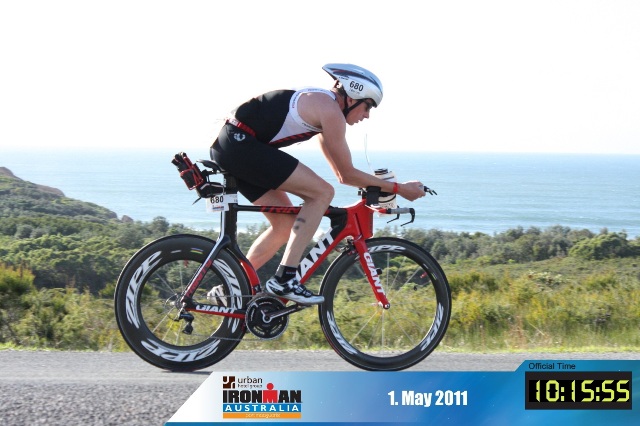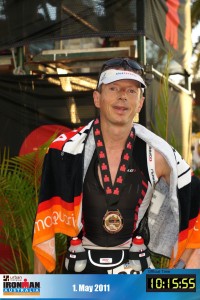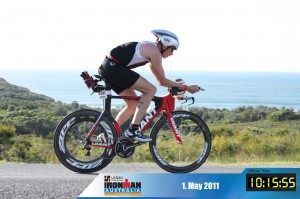Steve Banning heading to KONA

One of our ironmen athletes, Steve Banning, qualified for biggest ironman event in the world, KONA, Hawaii. There are a number of qualifing ironman events, where the top 3 or 4 athletes from each age group are invited to compete in Hawaii.
Steve Banning, aged 49, recently competed in the Port Macquarie Ironman, completing the gruelling course in 10hrs15min. The 3.8km swim, 180km bike ride and 42km marathon was described in one word to us after the race ‘brutal’.
So congratulations on your recent Ironman race in Port Macquarie Steve. Can you tell us a bit more about your preparation and training for the big day? How many hours do you train in a hard week? What are the main sessions you do?
Thanks guys. Hard weeks tend to be around 16-18hrs made up of 3 swim squad sessions, 4 bike sessions (usually 3 wind trainer pain sessions and a longer weekend ride), plus 4 runs (one of those runs is after a long ride and followed up by a long run up to 30k’s the next day).
How many ironman events have you done before this event? Was this one the hardest?
This was number 6 and I had a DNF in my last race late last year due to going in sick. Definitely the hardest conditions – the bike had about 900m of climbing but the real issue was the 25kmh+ head wind on the outward legs of the bike.
How did you carbo load and what quantity of food did this entail?
My favourite subject. Been trying out some strategies in previous races based on info from the AIS and other on-line sites so think I nailed it for the race. Basically was looking at about 750g per day of high GI foods for 3 days so that’s 6(!) meals/snacks a day comprising everything from Frosties to full strength coke to pasta. At the same time was also aiming for low fibre, low fat and reduced protein intake to encourage glycogen formation.
What did you eat on the morning of the race?
About 2 ½ hrs from race start I had a large bowl of frosties (teeth were nearly rotten by this point), crumpet with jam washed down with 750mls of Gatorade.
How did prepare in the hour leading up to the race start?
Having checked the bike, bike gear and run gear in the day before, it’s really just a time to check the bike over, get the bidons filled up, go over the race plan and join the very long line for the portaloos…..
Do you get in the water and do a little swim? Was it cool enough to allow wetsuits? Did you get stung by jelly fish or any other horrible creatures?
Water temp was 21c so wet suits were allowed (and recommended). At the race briefing we were told if we heard sirens going off during the swim that we should make our way to the nearest piece of high ground and get out of the water as quickly as possible. They didn’t mention the ‘s’ word but everyone knew what they were talking about! Wearing a dark wet suit makes you look remarkably like a seal so the strategy is always to swim in amongst the other ‘seals’ just to be sure….
How long did the swim leg take you? How did you feel in the water? Did you get kicked a lot? Was it a mass start or in waves?
Swim was 3.8k’s and took around 62 mins which was more or less what I thought. Being a deep water start with 1150 athletes and a start line about 100m wide as soon as the gun goes off all hell breaks loose. It was probably the roughest swim I’ve done in any tri – had my goggles kicked off, kicked again in the mouth and got some pretty deep scratches on my wrist – maybe there was a shark after all?? Being that rough it’s difficult to get into a rhythm but the time went by pretty quickly.
What was your strategy on the bike? Did you use HR as well as power for pacing? How often did you eat and drink? What did you mainly eat? You gained a lot of positions after the cycle leg. Were you aware you were in 5th position in your category after your cycle leg?
Strategy on the bike was to average around 200w and try and keep any of the climbs below 270w. I’ve got HR on display as well but only use it if for some reason it’s a lot higher than I’d expect. I knew riders would go past me early on but a 180km ITT is a long way and there was plenty of time to catch them later. The route was 45k out to a turnaround and then back, repeated twice. Going out we had a big headwind so 60 mins in and I was only averaging 31kmh and starting to think it would be a long day but I’d already started passing people so that was good. Nutrition strategy was 750mls sports drink per hour plus an endura gel (gives me about 80g per hour of carbs) plus water if I wanted something else to drink – I’ve found in the past that too many carbs per hour just shuts my gut down later on in the race. Hardest part of the course was a hill after 170k’s where to get up it I was riding just over 500w to make sure I didn’t fall off but it’s not what you want just before you start a marathon! At the end of the bike leg I knew I’d overtaken a lot of people and I thought there was only one guy that I’d gone past that I hadn’t managed to catch so guessed I was in reasonable shape but had no clue as to position.
And the business end of the event – the 42km run. Did it take you a while to get into a rhythm? What pace were you trying to hold? Can you describe how you felt during the different sections of the run? Was the 2nd lap a blur of pain? Were you cramping? What were you eating and drinking during the run?
The run was 4 x10.5 loops so I tried to break it down into bite sized chunks. Initially I wanted to get through 5k to see how I was feeling – unfortunately the legs didn’t feel too good but they did slowly start to improve. I deliberately chose not to look at my watch until the 12k mark because I know that it can work as much against you as for you. At 12k I was running 5min k’s so that was ok. I only looked at it once more before the finish. On the run they have aid stations every 2k’s and I was carrying gels with me as well so nutrition strategy was a gel at the first, Gatorade at the next followed by flat coke at the third and I just kept repeating that pattern. The run on an Ironman is 80% mental – your body would be more than happy to stop at any point! After 12k I promised myself I could walk if I got to 24k… . Although there were a lot of spectators and athletes out there I just switched it all off and tried to keep going. Having reached 24k I convinced myself the target was now 36k….. . There had been two guys ahead of me that I’d noticed and they both looked to be suffering when they had come back from the turnaround point so that now became the motivator and I was able to catch both of them. With about 1.5k to the finish another guy came past me who was in my age group – he was moving so easily I thought he couldn’t have been on his final lap but tried to speed up just in case. Unfortunately there was nothing left and it was his last lap so I lost a place right at the end.
And crossing the line – relief? Exhaustion? How did you recover? Please don’t tell us you drank a beer?
Relief big time. With a DNF last time, just finishing was pleasing but in those conditions I was really happy with the time. The body starts seizing up almost immediately and it rapidly becomes impossible to bend down to pick anything up off the floor. At the end of the race there’s a big medical tent for those needing intervention (IV drips etc) but there’s also massage, loads of food and so on. The beer happens at the closing party the next day!
And the best news of all. You have qualified for KONA. Congratulations Steve. Fantastic achievement. What is the data of the Kona event? What are your plans now?
A little recovery and then back into it? Kona is the 8th Oct – typically very hot, humid and windy. Trying to work out how I can acclimatise to those conditions through a Melbourne winter! Planning a couple of weeks off but will probably do some easy swimming during that time which aids recovery and then do so easy rides.



